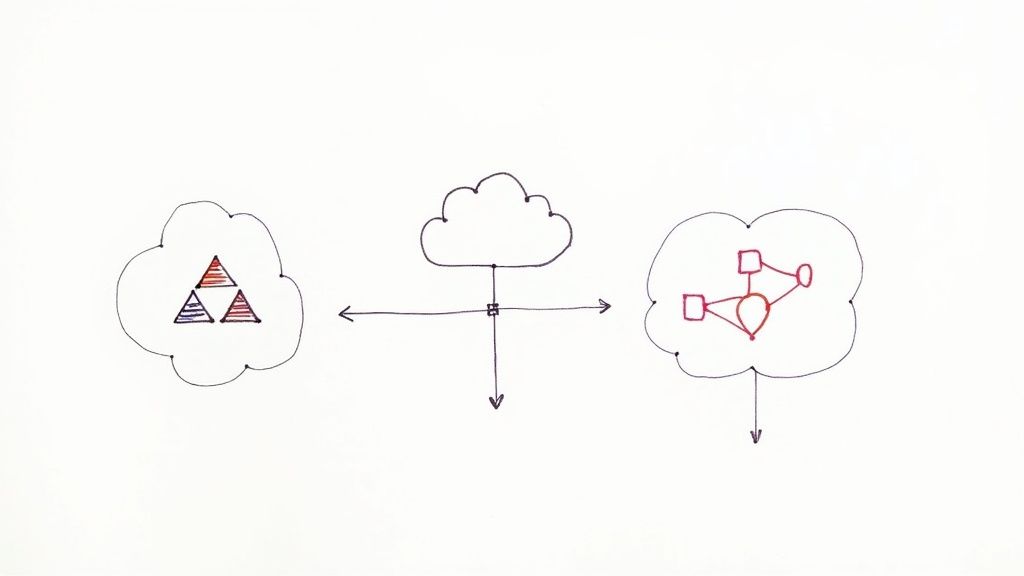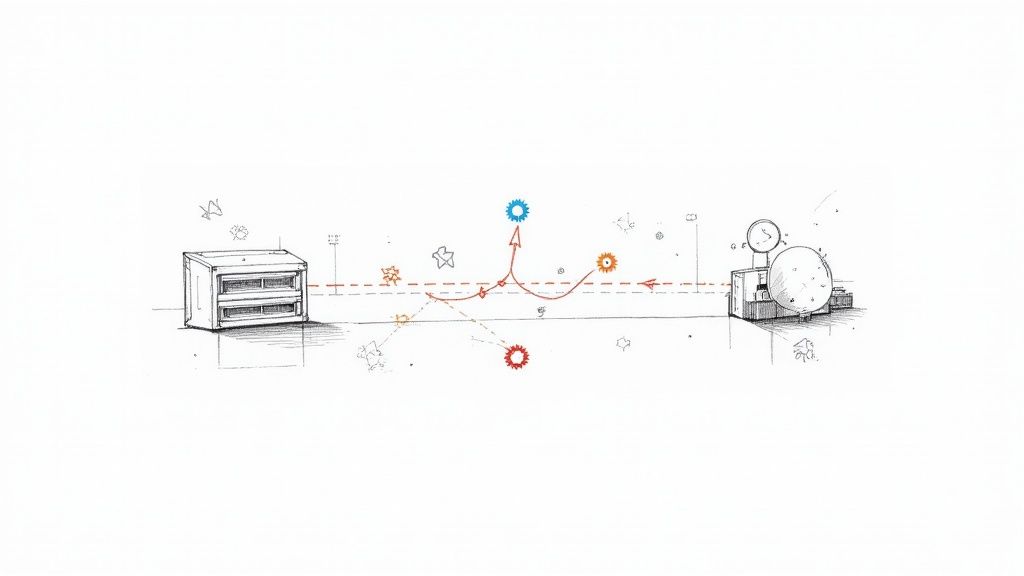What is an ETL Pipeline? Essential Data Workflow Explained
Learn what is an ETL pipeline, how it works, and why it's vital for data success. A simple, clear guide for beginners to master data integration.
At its core, an ETL pipeline is a sophisticated process for moving data from point A to point B. It’s the behind-the-scenes workhorse that collects raw information from all sorts of places, cleans it up, and then delivers it to a central location, like a data warehouse, where it can be analyzed.
Think of it as the plumbing of the data world—it’s not glamorous, but without it, nothing flows correctly.
What Is an ETL Pipeline, Really?
Let's use a real-world analogy. Imagine you're a chef preparing a gourmet meal with ingredients from a dozen different suppliers. The carrots are unwashed, the spices are in bulk bags, and the fish needs to be filleted. You can't just throw all of that into a pot.
An ETL pipeline is like your kitchen crew. They go out and get all the ingredients (Extract), wash, chop, and measure everything according to your recipe (Transform), and then neatly organize it on the counter so you're ready to cook (Load).
In a business context, the "ingredients" are data coming from all over the place:
- Customer data from a CRM like Salesforce
- Website traffic from Google Analytics
- Sales records from e-commerce databases
- Engagement metrics from social media
This raw data is almost always a mess. It's inconsistent, full of errors, and stored in different formats. The ETL process automates the thankless job of wrangling it into shape. Without it, data analysts would spend up to 80% of their time just cleaning data instead of actually analyzing it.
The Three Core Stages of an ETL Pipeline
The name ETL isn't just a random acronym; it stands for the three distinct stages that make the whole process work: Extract, Transform, and Load. Each step has a clear job to do, building on the one before it to make the data more valuable.
An ETL pipeline is what turns a chaotic flood of raw data into a clean, organized reservoir of information that a business can actually use to make smarter decisions. It’s the unsung hero behind accurate reports and powerful analytics.
Let's break down what happens at each stage.
This table gives a high-level look at how each phase contributes to the overall goal of producing analysis-ready data.
StageCore PurposeCommon ActivitiesExtractTo pull raw data from various source systems.Connecting to APIs, querying databases, reading files (CSVs, logs, JSON), scraping web pages.TransformTo clean, enrich, and standardize the data.Data cleansing (removing duplicates, handling nulls), validation, standardization, applying business rules, enrichment (joining data sets).LoadTo deliver the processed data to a target system.Inserting or updating records in a data warehouse, data mart, or data lake.
By structuring the process this way, ETL pipelines ensure that the data landing in your analytics systems is reliable, consistent, and ready for whatever you throw at it.
This methodical approach is what makes everything from simple sales dashboards to complex machine learning models possible. It takes the manual guesswork out of data preparation, cuts down on human error, and dramatically speeds up the journey from raw data to real business insight.
Deconstructing the Extract, Transform, and Load Process
To really get what an ETL pipeline is, you have to look under the hood at each stage of the process. Think of it like a digital assembly line that takes raw, jumbled-up data and methodically turns it into something refined and ready for analysis. Every step—Extract, Transform, and Load—has a specific and vital job to do.
This infographic gives you a great visual of how data is pulled from all sorts of different systems during that first extraction phase.
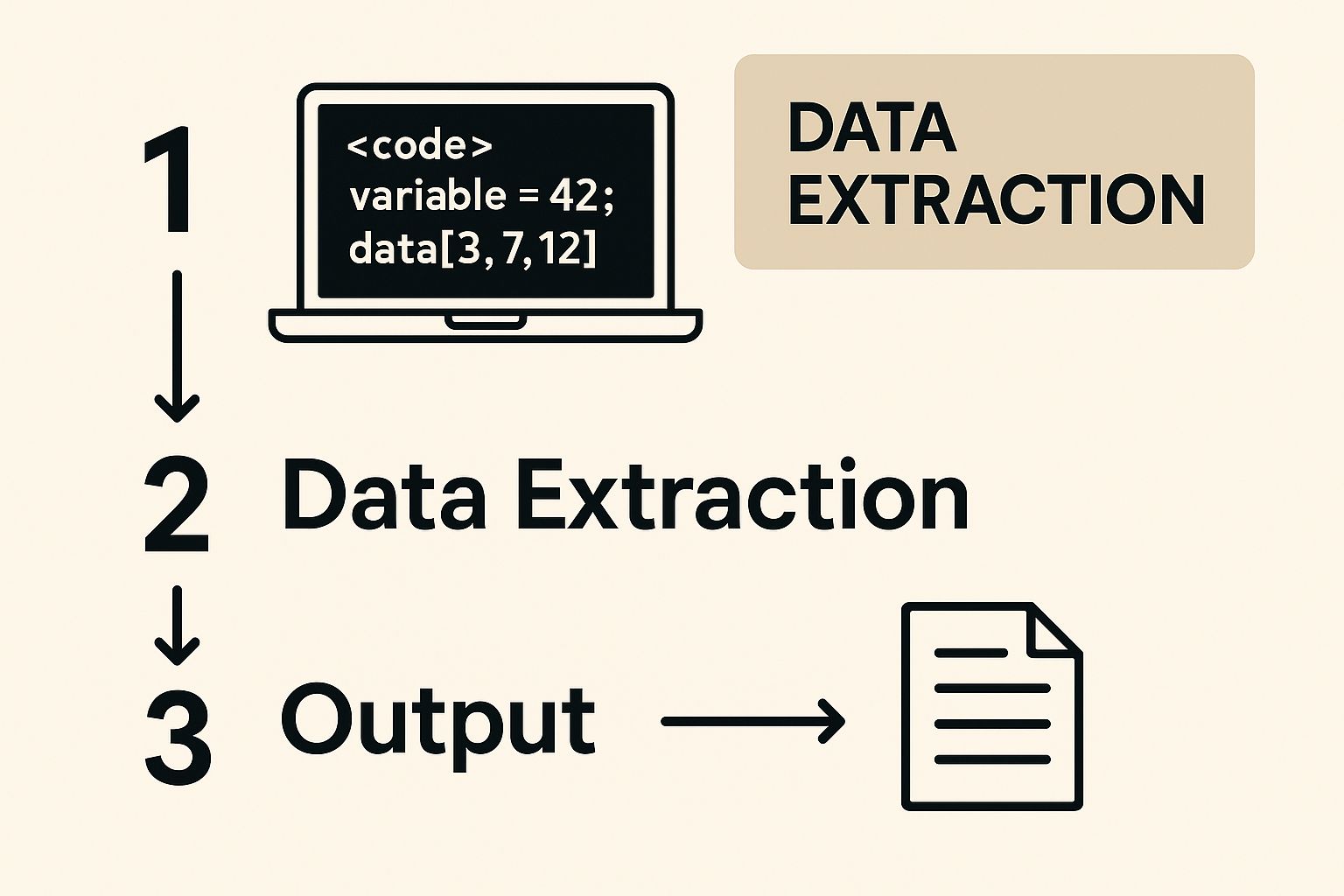
As you can see, extraction isn't a simple, single action. It’s a complex task of plugging into multiple, often mismatched, data systems to get the information out.
The First Step: Extract
It all starts with extraction—the process of gathering up the raw data from wherever it lives. This first stage is often the toughest part because modern businesses have data squirreled away in dozens of places. The 'Extract' phase is all about pulling that data from databases, files, and increasingly, web services via tools like a What is a REST API.
Data sources are everywhere:
- Transactional Databases: These are the systems running the daily show, tracking things like sales or inventory.
- SaaS Applications: Think of all the cloud-based tools your teams use for marketing, sales, or finance.
- Log Files: These are the digital breadcrumbs from servers that track user activity on a website or app.
- Spreadsheets: Good old-fashioned manual data entry from various departments.
The main goal here is just to get the data out of these silos and into a temporary holding area, often called a staging area, where it can be worked on.
The Middle Step: Transform
Once you've extracted it, the raw data is usually a mess. It's inconsistent, full of errors, and not very useful. This is where the transform stage comes in—and it's where the real magic happens. In a dedicated processing server, the data gets cleaned up, validated, and molded into a consistent, standard format. This is easily the most critical part of the entire ETL pipeline.
Transformation is what turns disorganized information into a valuable business asset. It ensures that by the time the data reaches its destination, it's clean, consistent, and ready for reliable analysis.
Let's take a retail company as an example. It might pull sales data where one system lists prices in USD and another in EUR. The transform step would convert everything to a single currency. It would also tidy up messy address fields and get rid of duplicate customer records.
The Final Step: Load
With the data all cleaned up and structured, it's ready for the final load phase. This step is about moving that data from the staging area into its permanent home, which is usually a data warehouse or data lake. These target systems are purpose-built for high-speed analysis and business intelligence.
Engineers typically use one of two loading strategies:
- Full Load: This is the simplest approach. The entire dataset in the destination is wiped and replaced with the new, transformed data. It’s straightforward but can be incredibly slow for large amounts of data.
- Incremental Load: A much more efficient method where only new or changed data is added. This is often handled using a clever technique called Change Data Capture. You can learn more about how that works in our guide on change data capture for streaming ETL.
Once these three steps are complete, what started as raw, operational data has been turned into a powerful resource that fuels smarter business decisions.
Why ETL Is a Cornerstone of Modern Data Strategy
It’s one thing to understand the mechanics of an ETL pipeline, but the real magic is in what it lets a business do. A well-built pipeline is so much more than a data mover; it's the engine that turns an organization's raw, messy information into a genuine strategic asset. By creating a single source of truth, ETL gets everyone—from the sales team on the ground floor to the executives in the C-suite—working from the same reliable playbook.
This unified view is the bedrock of trustworthy business intelligence. When your data is clean, standardized, and all in one place, your reports suddenly become more accurate. Your customer insights get sharper. Your predictive models can finally be built on solid ground. It’s the difference between making decisions based on fragmented guesswork and acting on cohesive, validated information.
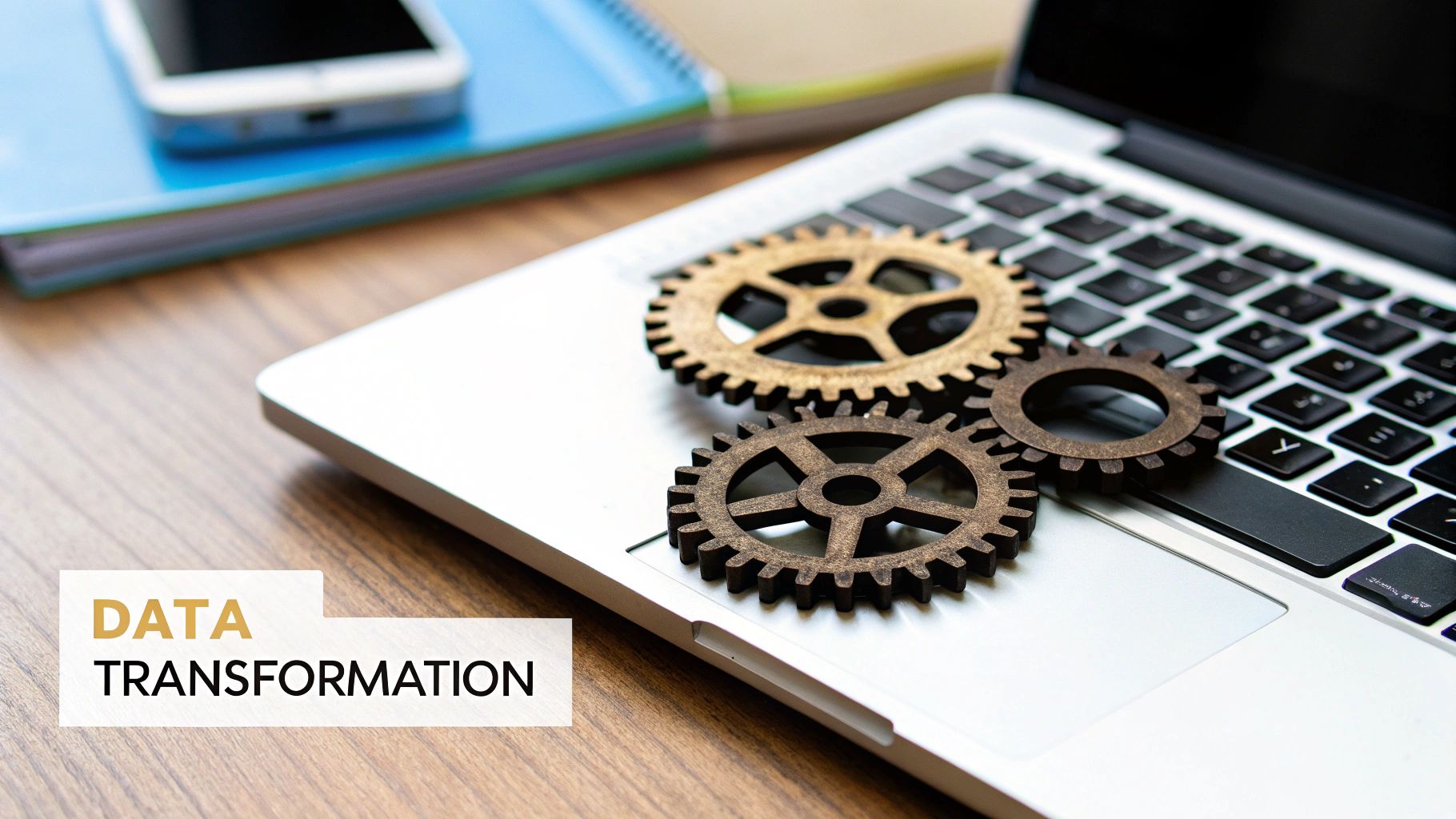
This shift directly impacts the bottom line. The market for ETL tools, valued at roughly $488 million in 2023, is on a trajectory to blast past $1 billion by 2032. This isn't just random growth; it’s being fueled by industries like finance and healthcare where getting data integration right is absolutely critical. It’s a clear signal that businesses see these systems as a vital investment. You can dig deeper into these data integration trends at Integrate.io.
Boosting Efficiency and Governance
Beyond just better decision-making, automated ETL pipelines bring huge operational wins. They take what used to be an incredibly complex and error-prone manual chore and turn it into a smooth, repeatable process. This automation frees up your data engineers and analysts from the drudgery of data prep, letting them focus on work that actually creates value.
Think about these key advantages:
- Reduced Manual Errors: Automation practically eliminates the risk of human error during data handling, which means higher-quality data across the board.
- Improved Scalability: As your data volumes explode—and they will—an automated pipeline can easily scale to meet the demand without needing an army of people to manage it.
- Enhanced Data Governance: ETL establishes a clear, documented journey for data from its source to its destination, making things like compliance and auditing much simpler.
By standardizing how data is processed and moved, an ETL pipeline builds a framework for strong data governance. It creates a clear audit trail, showing exactly what transformations were applied, which is essential for regulatory compliance.
The Strategic Value of Reliable Data
At the end of the day, the real power of an ETL pipeline comes down to the trust it builds. When leaders and decision-makers have confidence in their data, they can act more decisively and with greater conviction.
Whether it’s launching a new marketing campaign, fine-tuning a supply chain, or creating personalized customer experiences, the data underneath it all has to be dependable. A truly effective data strategy always starts with a reliable way to prepare and deliver information—and that’s exactly what a modern ETL pipeline is designed to do.
How ETL Pipelines Actually Work in the Real World
It's one thing to talk about ETL in theory, but where do these data pipelines really make a difference? You might be surprised to learn they're the unsung heroes humming away behind the scenes in retail, healthcare, and finance. They quietly take all the messy, disconnected data a business generates and turn it into something genuinely useful.
Let’s look at a few examples of how different industries put ETL to work every single day.
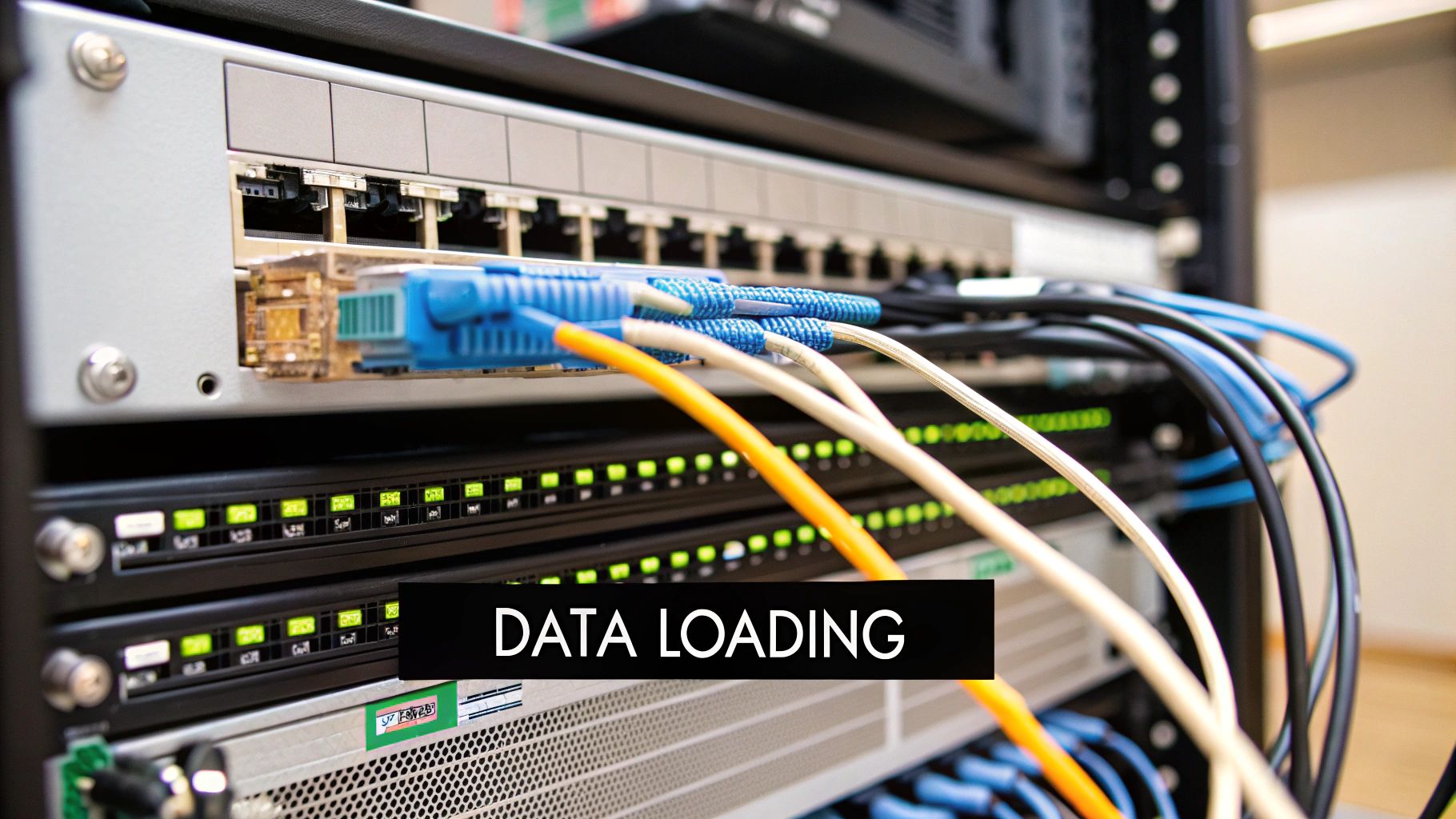
In each of these cases, the goal is the same: solve a nagging business problem by creating a single, trustworthy source of data that people can actually use to make smarter decisions.
Making Personalization Possible in Retail
Imagine a huge retail brand. They have a popular e-commerce website, hundreds of brick-and-mortar stores, and a slick mobile app. Each one of these channels is a goldmine of data, but they all speak different languages and live in separate silos.
This creates a massive blind spot. The company has no way of knowing if a customer who browsed a jacket on the app yesterday is the same person who walked into a store and bought it today. Without that connection, any attempt at personalization is just a shot in the dark.
This is a classic job for an ETL pipeline. Every night, an automated process kicks off:
- It extracts sales data from the website’s database.
- It pulls transaction logs from the in-store point-of-sale (POS) systems.
- It grabs user activity from the mobile app’s analytics.
Then comes the magic. The transform step cleans up all this messy data, standardizing everything from product names to customer IDs. It stitches together each customer's activity into a single, cohesive story. Finally, it loads this unified data into a central data warehouse.
The payoff? The marketing team now has a true 360-degree view of each customer. They can send relevant product recommendations, understand which online ads actually drive in-store foot traffic, and build loyalty programs that feel genuinely personal.
Improving Patient Outcomes in Healthcare
A sprawling hospital network is a maze of disconnected systems. You've got Electronic Health Records (EHRs) in one database, lab results in another, billing information somewhere else, and pharmacy records in yet another system. None of them talk to each other, which can complicate care and even put patients at risk.
By integrating disparate patient records into a single, cohesive view, healthcare providers can make faster, more informed clinical decisions that directly improve patient outcomes and operational efficiency.
An ETL pipeline is the critical link. It carefully extracts patient data from each source, transforms it by matching up patient identifiers and standardizing medical codes (like ICD-10), and then loads it all into a secure, HIPAA-compliant clinical data warehouse.
With this unified view, a doctor can see a patient’s complete history at a glance. This leads to better diagnoses, helps prevent dangerous drug interactions, and ultimately saves lives.
Catching Fraud in Financial Services
Think about a major bank or credit card company. They have to monitor millions of transactions every single day, looking for the telltale signs of fraud. This data pours in from credit card processors, online banking portals, and ATM networks—and it's all in a different format.
An ETL pipeline is absolutely essential here. It ingests the constant stream of transaction data, quickly standardizing it and adding valuable context, like geolocation.
This clean, enriched data is then fed into a powerful analytics engine. Machine learning models can then sift through it in near real-time, instantly flagging suspicious patterns that a human would miss. This protects both the company and its customers from potentially devastating financial loss.
Understanding ELT and Modern Data Pipelines
The world of data moves fast, and the traditional ETL pipeline has had to evolve to keep up. As businesses started demanding insights in near real-time and dealing with massive amounts of data, the classic model started to show its age. This led to some powerful new approaches that offer a whole new level of flexibility.
One of the biggest game-changers has been the rise of ELT (Extract, Load, Transform). As you can probably guess from the name, this model completely flips the last two stages of the traditional process on their head. Instead of transforming data on a separate server, ELT taps into the raw power of modern cloud data warehouses like Snowflake or Google BigQuery.
The Rise of ELT
In an ELT workflow, you extract raw data from your sources and load it directly into the target data warehouse. All the heavy lifting—the cleaning, standardizing, and structuring—happens after the data has already landed in its final destination.
This approach really took off with the advent of affordable cloud storage and scalable computing. Suddenly, it was practical and cost-effective to store huge volumes of raw, unprocessed data. The main advantage here is speed. By pushing the transformation step to the end, data becomes available in the warehouse almost instantly. This is a massive win for analysts and data scientists who might want to explore the raw data before it gets locked into a final, rigid format. It also means the original, untouched data is always there, which can be a lifesaver for future analysis.
ELT follows a "load first, ask questions later" philosophy. By using the data warehouse as its transformation engine, it separates the simple act of loading data from the complex, often time-consuming business logic of transformation. The result? Faster access to your data.
ETL vs ELT A Head-to-Head Comparison
So, should you use ETL or ELT? The honest answer is: it depends. Your choice hinges on your specific needs, the kind of data you're working with, and your existing infrastructure. Neither one is better than the other; they're just different tools for different jobs.
This table breaks down the core distinctions between them.
CharacteristicETL (Extract, Transform, Load)ELT (Extract, Load, Transform)Transformation LocationOccurs in a dedicated staging server before loading.Happens directly within the target data warehouse after loading.Data LoadingLoads only structured, transformed data into the warehouse.Loads raw, unprocessed data directly into the warehouse.Best ForStructured data, compliance-heavy industries, on-premise warehouses.Large volumes of unstructured data, cloud data warehouses, speed.ToolsTraditional, often on-premise tools like Informatica.Modern, cloud-native tools designed for scalability.
Ultimately, ELT gives you more flexibility and speed, making it a great fit for the cloud era. ETL, on the other hand, remains a solid choice for more structured, predictable workloads where data privacy and compliance are paramount.
Beyond Batches: Streaming Data Pipelines
Another massive evolution in data pipelines is the shift away from batch processing toward real-time data movement. Traditional ETL and ELT pipelines usually run on a schedule—maybe once an hour or even just once a day. But for many modern businesses, that’s just too slow. Think about use cases like fraud detection, live inventory management, or real-time personalization; you can't afford to wait.
This is where streaming data pipelines enter the picture. Instead of processing data in big chunks, streaming pipelines handle data event-by-event, as soon as it's created. This approach delivers information with incredibly low latency, often within milliseconds. You can dive deeper into the mechanics of this in our guide to real-time data streaming.
The market reflects this growing need for speed. The data pipeline tools industry is projected to explode from $12 billion to over $33 billion by 2030, a surge driven by the demand to process constant streams of data from countless digital sources. You can find more on the market's trajectory in this data pipeline tools report from Grand View Research. This fundamental shift from batch to stream is all about empowering businesses to react to information the moment it happens.
Choosing the Right Tools for Your ETL Pipeline
Picking the right tools for your ETL pipeline is where your data strategy stops being a plan on paper and starts becoming a reality. The market is packed with options, from massive enterprise platforms to nimble open-source frameworks and modern cloud services. The trick is to cut through the noise and figure out what truly fits your business.
The data pipeline tool market is absolutely exploding. Projections show it rocketing from roughly $12.09 billion to over $29 billion by 2029. What's really telling is that 71.5% of this market is software and tools, which points to a huge shift toward self-service platforms that put the power in more people's hands. This isn't just a trend for the big players; it's opening up data integration for small and medium businesses like never before.
Key Categories of ETL Tools
Most tools fall into one of a few main buckets. Knowing the difference will help you zero in on what makes sense for your team's skills, your budget, and how much you expect to grow.
- Enterprise Tools: Think of platforms like Informatica. These are the heavyweights, built for massive operations with complex governance and compliance rules. They’re comprehensive, robust, and designed for large-scale, intricate data environments.
- Open-Source Frameworks: Here, tools like Apache Airflow reign supreme. They give you incredible flexibility and total control, but you need the engineering muscle to back it up. If your team loves to build and customize every detail of their workflows, this is your playground.
- Cloud-Native Services: Services like AWS Glue are all about managed, serverless infrastructure that scales up or down as you need it. This is a fantastic choice for companies already in the cloud who want to keep their operational headaches to a minimum.
Choosing an ETL tool isn't just a technical decision; it's a strategic one. The right platform should not only solve today's data challenges but also scale to meet tomorrow's demands, empowering your team without creating unnecessary complexity.
As you start hooking different services into your workflow, you'll also need to handle authentication securely. Getting comfortable with the basics of how to get an API key is a must-have skill for connecting data sources and destinations without compromising security.
Once you’ve got your tools sorted, it's time to start building. You can get a running start by checking out our guide on how to build data pipelines.
Common Questions About ETL Pipelines
Even after getting the basics down, a few questions always seem to pop up when people are trying to wrap their heads around ETL pipelines. Let's clear up some of the most common points of confusion.
What Is the Main Difference Between an ETL Pipeline and a Data Pipeline?
It helps to think of "data pipeline" as the umbrella term for any process that moves data from point A to point B. An "ETL pipeline" is simply a very specific type of data pipeline.
All ETL pipelines are data pipelines, but not all data pipelines are ETL. The key is the rigid Extract, Transform, Load sequence. Some modern variations, like ELT, flip the order, while other data pipelines might not involve any transformation at all.
How Often Do ETL Pipelines Typically Run?
There's no single answer here—it really comes down to what the business needs. Many traditional ETL jobs run in big batches, often overnight, so that fresh reports are ready by morning. For less urgent tasks, they might only run weekly or even monthly.
If the data is needed more frequently, say for operational dashboards, a pipeline might be scheduled to run every hour. But when you need data right now, businesses typically look beyond traditional ETL and toward real-time streaming pipelines instead.
Do You Need to Code to Build an ETL Pipeline?
Not like you used to. In the past, building an ETL pipeline was squarely in the developer's court, requiring custom code in languages like Python.
Today, the game has changed. A whole ecosystem of low-code or no-code tools has emerged. These platforms give you a visual, drag-and-drop canvas to design, schedule, and manage your data workflows without writing a single line of code, opening up data integration to a much broader audience.
Ready to move beyond slow, batch-based processing? Streamkap offers a real-time streaming ETL platform that replaces outdated workflows with modern, efficient data movement. Start building your pipelines in minutes.


